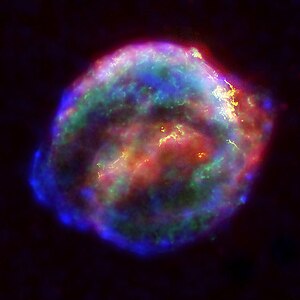Supernova 1604
| Supernova | |
|---|---|
| SN 1604 | |

|
|
| The remnant of Supernova 1604 (composite image from observation in the X-ray, optical and infrared range) | |
| Constellation | Snake bearer |
|
Position equinox : J2000.0 |
|
| Right ascension | 17h 30m 35.98s |
| declination | −21 ° 28 ′ 56.23 ″ |
| Further data | |
| Brightness (visual) |
−2.5 mag |
| Angular expansion |
4 ′ |
| distance | |
| Affiliation | |
| Type | |
| history | |
| discovery |
Ilario Altobelli and Raffaello Gualterotti |
| Date of discovery |
October 9, 1604 |
| Catalog names | |
| ESO 588-4 • IRAS 17276-2126 • V843 Oph • 3C 358 | |
| Aladin previewer | |
The Supernova 1604 (SN1604), also Kepler's Supernova or Kepler's Star called, was a galactic supernova that in 1604 roughly 6,000 parsecs (20,000 light years ) away in the constellation Ophiuchus (Ophiuchus) appeared. With an apparent magnitude of −2.5 mag , it was the brightest star in the night sky. It was the last supernova to date to be observed in the Milky Way when it erupted. It was a thermonuclear supernova of type Ia .
history
The supernova was first observed on October 9, 1604 by Ilario Altobelli in Verona and Raffaello Gualterotti in Florence. On October 10th they observed Baldassare Capra, Simon Marius and Camillo Sasso in Padua.
At the same time, on October 10, the supernova was discovered in China, and a few days later in Korea, with the Chinese and Korean astronomers leaving detailed records of their systematic observations of the phenomenon over almost a year.
The astronomer Johannes Kepler, on the other hand, observed the supernova for the first time on October 17th and, following the occurrence and decay of the nova, first wrote a brief, German-language text explaining the phenomenon ( Thorough report from an unusual Newen Stern , five editions 1604 and 1605 in Prague, Strasbourg and Amberg). In his book De Stella nova in pede Serpentarii ("About the new star in the foot of the snake-bearer", Prague and Frankfurt am Main 1606), Kepler wrote another detailed study of the phenomenon, now in Latin, which is also the reason for it that the object, although Kepler was not the first to discover it, was ultimately named after him.
Finally, Galileo Galilei , then a professor at the University of Padua , did not see the supernova for the first time until October 28th, whereupon he gave three public lectures on the phenomenon because of the great general interest.
Initially as bright as Mars , the “new star” with an estimated maximum of −2.5 mag was even brighter than Jupiter after a few days . From November 1604, however, the supernova was no longer visible at dusk, and when it reappeared in the night sky in January 1605, it was still brighter than Antares . Kepler last observed her on October 8, 1605 - so all in all she was seen for almost exactly a whole year.
The nature of the object
The 1604 supernova aroused great interest because it coincided with a major conjunction of Jupiter, Saturn, and Mars, calculated for October 8, 1604. The supernova was therefore seen by many as a product of this conjunction. Due to the lack of parallax , observations in Italy and Northern Europe suggested that, as with the supernova of 1572 observed only 32 years earlier , it must be an object beyond the moon. The appearance of another new celestial body beyond the lunar orbit finally shook the belief in Aristotelian cosmology, according to which the spheres of the planets and fixed stars were immutable.
Based on the light curve reconstructed from the historical data, we now know that it must have been a type Ia supernova.
The supernova remnant
In 1941, a faint nebula with a brightness of around 19 mag was discovered with the 100-inch telescope of the Mount Wilson Observatory at the expected location, which is the remnant of the supernova from 1604. Only a few filaments can be seen in visible light, but the supernova remnant is a powerful radio source . The diameter is around 4 minutes of arc. The distance to the object is not exactly known and is between 3 and more than 7 kpc (10,000 to 23,000 light years) depending on the model used .
See also
literature
- M. Turatto, S. Benetti, L. Zampieri, W. Shea (Eds.): 1604-2004: Supernovae as Cosmological Lighthouses (= ASP Conference Series. Volume 342). San Francisco 2005, ISBN 1-58381-209-1 ( online ).
Web links
- Bill Blair's Kepler's Supernova Remnant Page (English, further links)
- SN 1604, Kepler's Supernova (English)
Individual evidence
- ↑ SIMBAD database
- ↑ a b c D. J. Patnaude, C. Badenes, S. Park, JM Laming: The Origin of Kepler's Supernova Remnant. The Astrophysical Journal , 756, 6 (2012), doi: 10.1088 / 0004-637X / 756/1/6 , arxiv : 1206.6799 .
- ^ A b W. Baade: Nova Ophiuchi of 1604 as a Supernova. The Astrophysical Journal, 97, pp. 119-127 (1943), doi: 10.1086 / 144505 .
